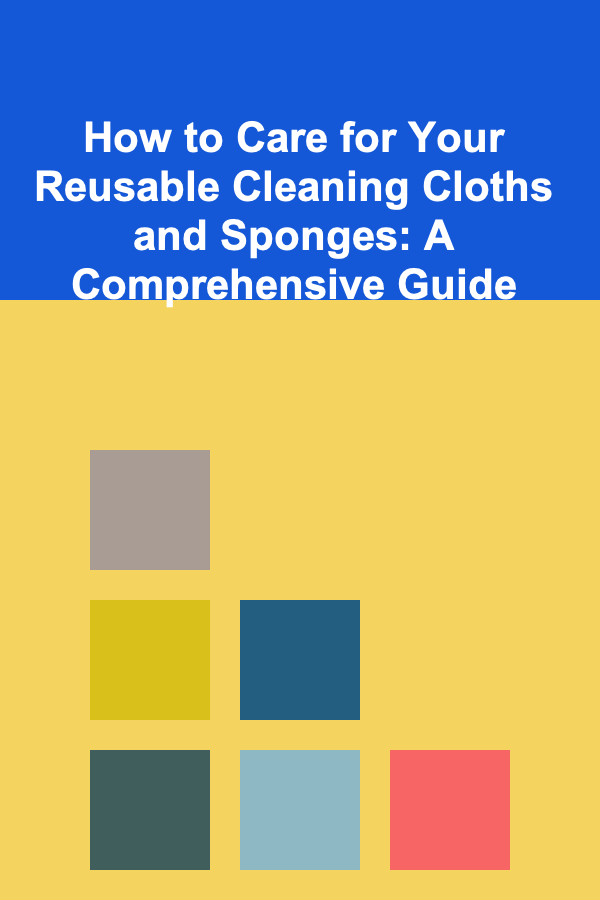
How to Care for Your Reusable Cleaning Cloths and Sponges: A Comprehensive Guide
ebook include PDF & Audio bundle (Micro Guide)
$12.99$9.99
Limited Time Offer! Order within the next:

In the quest for a more sustainable and eco-friendly lifestyle, switching to reusable cleaning cloths and sponges is a significant step. These alternatives reduce waste, save money in the long run, and can often be more effective than disposable options. However, reaping the full benefits of reusable cleaning tools hinges on proper care. Neglecting their upkeep can lead to bacterial growth, unpleasant odors, reduced effectiveness, and a shortened lifespan. This comprehensive guide will delve into the best practices for cleaning, disinfecting, and maintaining your reusable cleaning cloths and sponges, ensuring they remain hygienic, effective, and contribute to a healthier home environment.
Why Proper Care Matters
Before diving into the specifics of cleaning and maintenance, it's crucial to understand why proper care is so essential. Reusable cleaning cloths and sponges, by their very nature, come into contact with a variety of surfaces and substances -- dirt, grime, food particles, spills, and cleaning solutions. These materials can create a breeding ground for bacteria, mold, and mildew. Ignoring proper cleaning protocols can lead to:
- Bacterial Growth: Warm, moist environments are ideal for bacterial proliferation. Cloths and sponges used in kitchens and bathrooms, if not properly cleaned, can harbor harmful bacteria like E. coli, Salmonella, and Staphylococcus aureus.
- Unpleasant Odors: Bacterial and fungal growth often results in foul odors, making cleaning a less pleasant experience and potentially signaling a health hazard.
- Reduced Effectiveness: Dirty cloths and sponges lose their absorbency and ability to effectively lift dirt and grime. They can even spread contaminants around instead of cleaning them up.
- Shorter Lifespan: Neglecting proper cleaning will cause cloths and sponges to degrade more quickly, requiring more frequent replacements and negating the environmental benefits of using reusable options.
- Health Risks: Using contaminated cloths and sponges can transfer bacteria and pathogens to surfaces, potentially causing illness, especially in households with young children, elderly individuals, or people with compromised immune systems.
Understanding Different Types of Reusable Cleaning Cloths and Sponges
The materials used to make reusable cleaning cloths and sponges vary widely, and each material requires slightly different care. Common types include:
Microfiber Cloths
Microfiber cloths are made from synthetic fibers, typically polyester and polyamide. They are highly absorbent, durable, and excellent at trapping dirt and dust. They are generally easy to clean and maintain.
Cotton Cloths
Cotton cloths are a natural, absorbent option. They are often less expensive than microfiber but may not be as durable or effective at trapping fine particles. They can shrink with high heat washing and drying.
Bamboo Cloths
Bamboo cloths are made from bamboo fibers, which are naturally absorbent and antimicrobial. They are a sustainable and eco-friendly option. However, some bamboo cloths can be delicate and require gentle handling.
Cellulose Sponges
Cellulose sponges are made from wood pulp and are biodegradable. They are absorbent and versatile but can harbor bacteria if not cleaned properly.
Silicone Sponges
Silicone sponges are non-porous and resistant to bacteria. They are durable and easy to clean, making them a hygienic option. However, they may not be as absorbent as other types of sponges.
Loofah Sponges (Natural and Synthetic)
Natural loofah sponges are derived from the loofah plant. They offer good scrubbing power but can be challenging to clean thoroughly due to their porous structure. Synthetic loofah sponges are often more durable and easier to sanitize.
Daily Cleaning Routines
Establishing a daily cleaning routine is crucial for preventing the buildup of bacteria and grime. This doesn't have to be a time-consuming chore, but a few simple steps can make a big difference:
Rinsing After Each Use
The most basic, yet essential, step is to rinse your cleaning cloths and sponges thoroughly with hot water after each use. This removes loose debris and prevents it from drying and hardening onto the material. For cloths used with particularly dirty or greasy substances, use a small amount of dish soap during rinsing.
Wringing Out Excess Water
After rinsing, wring out as much water as possible from cloths and sponges. This helps prevent bacterial growth by depriving them of a moist environment. A dry cloth or sponge is a happy, hygienic cloth or sponge.
Air Drying
Allow cloths and sponges to air dry completely in a well-ventilated area. Avoid leaving them damp in a sink or on a countertop, as this encourages bacterial growth. Consider using a drying rack or hanging them from a hook to promote airflow.
Deep Cleaning and Disinfection Methods
In addition to daily rinsing, regular deep cleaning and disinfection are necessary to eliminate bacteria, mold, and mildew. Several effective methods can be employed:
Machine Washing (for Cloths)
Machine washing is a convenient and effective way to clean reusable cleaning cloths. Follow these guidelines:
- Separate Laundry: Wash cleaning cloths separately from your regular laundry to prevent cross-contamination.
- Water Temperature: Use hot water (at least 140°F/60°C) to kill bacteria effectively.
- Detergent: Use a good quality laundry detergent. Avoid detergents with added fragrances or dyes, as these can leave a residue on the cloths. Consider using a natural or eco-friendly detergent.
- Bleach (Optional): For heavily soiled or potentially contaminated cloths, you can add a small amount of bleach to the wash cycle. Follow the bleach manufacturer's instructions carefully and ensure proper ventilation. Never mix bleach with ammonia or other cleaning products, as this can create dangerous fumes.
- Drying: Tumble dry on high heat to further kill bacteria. Alternatively, air dry in direct sunlight, which has natural disinfecting properties.
- Fabric Softener: Avoid using fabric softener, as it can reduce the absorbency of microfiber and other cleaning cloths.
Microwaving (for Sponges)
Microwaving is a quick and easy way to disinfect cellulose and silicone sponges. However, it's important to follow these precautions:
- Wet the Sponge: Ensure the sponge is thoroughly wet before microwaving. A dry sponge can catch fire.
- Microwave Time: Microwave on high power for 1-2 minutes. The heat will kill most bacteria and fungi.
- Cooling Time: Allow the sponge to cool down before handling, as it will be very hot.
- Odor Test: If the sponge still smells unpleasant after microwaving, it may be time to replace it.
- Material Compatibility: This method is generally safe for cellulose and silicone sponges. Do not microwave sponges with metal components or abrasive scrub pads.
Boiling (for Cloths and Sponges)
Boiling is an effective method for disinfecting both cloths and sponges. Follow these steps:
- Submerge: Place the cloths or sponges in a pot of boiling water.
- Boil Time: Boil for 10-15 minutes to kill bacteria and fungi.
- Cooling: Carefully remove the cloths or sponges from the boiling water and allow them to cool down before handling.
- Wringing and Drying: Wring out excess water and allow the cloths or sponges to air dry completely.
Soaking in a Disinfectant Solution
Soaking cloths and sponges in a disinfectant solution is another effective way to kill bacteria. Several options are available:
- Vinegar Solution: Soak cloths and sponges in a solution of equal parts white vinegar and water for at least 30 minutes. Vinegar is a natural disinfectant that can kill many types of bacteria and fungi.
- Bleach Solution: Prepare a dilute bleach solution by adding 1 tablespoon of bleach to 1 gallon of water. Soak cloths and sponges in the solution for 5-10 minutes. Rinse thoroughly with clean water after soaking. Always use gloves when working with bleach and ensure proper ventilation.
- Hydrogen Peroxide Solution: Soak cloths and sponges in a 3% hydrogen peroxide solution for at least 10 minutes. Hydrogen peroxide is a powerful disinfectant that is effective against bacteria, viruses, and fungi.
- Commercial Disinfectant Cleaners: Follow the manufacturer's instructions for using commercial disinfectant cleaners. Ensure the cleaner is safe for the materials of your cloths and sponges.
Specific Care Tips for Different Materials
As mentioned earlier, different materials require slightly different care. Here are some specific tips:
Microfiber Cloths
- Wash in hot water with a mild detergent.
- Avoid fabric softener and bleach, as they can damage the fibers.
- Tumble dry on low heat or air dry.
- Wash microfiber cloths separately from other laundry, as they can attract lint.
Cotton Cloths
- Wash in hot water with a mild detergent.
- Bleach can be used for heavily soiled cloths.
- Tumble dry on high heat, but be aware that cotton can shrink.
Bamboo Cloths
- Wash in cold or warm water with a mild detergent.
- Avoid bleach and fabric softener.
- Air dry or tumble dry on low heat.
- Bamboo cloths can be delicate, so handle them with care.
Cellulose Sponges
- Rinse thoroughly after each use and wring out excess water.
- Microwave or boil regularly to disinfect.
- Replace frequently, as cellulose sponges tend to degrade quickly.
Silicone Sponges
- Rinse thoroughly after each use.
- Wash in the dishwasher or by hand with soap and water.
- Silicone sponges are very durable and easy to clean.
Loofah Sponges
- Rinse thoroughly after each use and allow to dry completely.
- Soak in a disinfectant solution regularly.
- Natural loofah sponges can be difficult to clean thoroughly and may need to be replaced more frequently than other types of sponges.
- Synthetic loofah sponges are generally more durable and easier to sanitize.
Extending the Lifespan of Your Cleaning Cloths and Sponges
Beyond cleaning and disinfection, several practices can help extend the lifespan of your reusable cleaning tools:
Dedicated Use
Designate specific cloths and sponges for specific tasks. For example, use separate cloths for cleaning the kitchen, bathroom, and floors. This helps prevent cross-contamination and reduces the wear and tear on each cloth or sponge.
Avoid Abrasive Surfaces
Avoid using delicate cloths and sponges on abrasive surfaces, such as scouring pads or heavily textured materials. This can damage the fibers and shorten their lifespan. Choose more durable options for tough cleaning tasks.
Proper Storage
Store clean, dry cloths and sponges in a well-ventilated area. Avoid storing them in closed containers or damp environments, as this can encourage bacterial growth. Consider using a designated storage bin or drawer.
Regular Inspection
Regularly inspect your cleaning cloths and sponges for signs of wear and tear, such as frayed edges, tears, or discoloration. Replace them when they become excessively worn or damaged.
Sunlight Exposure
Air drying cloths in direct sunlight can naturally help disinfect them due to the UV rays. Be mindful that excessive sun exposure can, over a long period, cause some fading or weakening of fibers, particularly in darker colored cloths.
When to Replace Your Cleaning Cloths and Sponges
Even with the best care, reusable cleaning cloths and sponges will eventually need to be replaced. Here are some signs that it's time for a replacement:
- Persistent Odors: If your cloths or sponges still smell unpleasant after cleaning and disinfecting, it's time to replace them.
- Visible Mold or Mildew: If you see visible mold or mildew growth, discard the cloth or sponge immediately.
- Excessive Wear and Tear: If the cloth or sponge is excessively worn, torn, or frayed, it's no longer effective and should be replaced.
- Loss of Absorbency: If the cloth or sponge has lost its absorbency and is no longer able to effectively lift dirt and grime, it's time for a replacement.
- Recommended Replacement Schedule: As a general guideline, consider replacing cellulose sponges every 1-2 weeks, microfiber cloths every few months, and other types of cloths and sponges as needed based on their condition. This is dependent on the frequency of use and how well they are cleaned.
The Environmental Impact of Reusable Cleaning Tools
Switching to reusable cleaning cloths and sponges has a significant positive impact on the environment by reducing waste and conserving resources. Disposable paper towels and sponges contribute to landfills, while reusable options can be used repeatedly for months or even years. This reduces the demand for new materials and the energy required to produce them.
Furthermore, using reusable cleaning tools can reduce your reliance on disposable cleaning products, many of which contain harsh chemicals that can be harmful to the environment. By choosing eco-friendly cleaning solutions and reusable tools, you can minimize your environmental footprint and contribute to a more sustainable future.
Conclusion
Caring for your reusable cleaning cloths and sponges is an essential part of maintaining a hygienic and sustainable home. By following the cleaning, disinfection, and maintenance tips outlined in this guide, you can ensure that your cleaning tools remain effective, long-lasting, and contribute to a healthier environment. Embrace the switch to reusable options and enjoy the benefits of a cleaner home and a greener planet.

How to Create a Relaxing and Beautiful Spa-Themed Party at Home
Read More
How to Improve Your Credit Score in 90 Days
Read More
How to Make the Most of Family Activities in the House
Read More
Software Architect's Toolkit: Essential Tools and Techniques for Creating Robust Systems
Read More
How To Understand Biometric Data Privacy Concerns
Read More
How to Deal with Separation Anxiety
Read MoreOther Products

How to Create a Relaxing and Beautiful Spa-Themed Party at Home
Read More
How to Improve Your Credit Score in 90 Days
Read More
How to Make the Most of Family Activities in the House
Read More
Software Architect's Toolkit: Essential Tools and Techniques for Creating Robust Systems
Read More
How To Understand Biometric Data Privacy Concerns
Read More